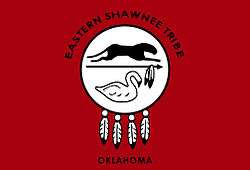Eastern Shawnee Tribe of Oklahoma
 | |
| Total population | |
|---|---|
| (2,801[1]) | |
| Regions with significant populations | |
|
| |
| Languages | |
| Shawnee, English | |
| Religion | |
| Christianity, traditional tribal religion | |
| Related ethnic groups | |
| Absentee-Shawnee Tribe of Indians of Oklahoma, Shawnee Tribe, and Sac and Fox |
The Eastern Shawnee Tribe of Oklahoma is one of three federally recognized Shawnee tribes. They are located in Oklahoma and Missouri.
The tribe holds an annual powwow every September at their tribal complex.[2]
Government
The headquarters of the Eastern Shawnee Tribe are Wyandotte, Oklahoma, and their tribal jurisdictional area is in Ottawa County, Oklahoma. Currently, there are 2,801 enrolled tribal members, with 904 of them living within the state of Oklahoma.
Glenna J. Wallace is the elected chief, currently serving a four-year term.[1] The Eastern Shawnee Tribe issues its own tribal vehicle tags.[1]
Membership to the tribe is based on lineal descent,[1] that is, the tribe has no minimum blood quantum requirements.
Economic development
The Eastern Shawnee operate their own housing authority as well as the People's Bank of Seneca, Missouri; the Eastern Shawnee Print Shop; Red Stone Construction Company; Four Feathers Recycling; Longhouse Management, as well as two casinos, a bingo hall, a gas station, a truck stop, and an off-track wagering facility.[1][3] Their annual economic impact is estimated by the Oklahoma Indian Affairs Commissions to be $164,000,000.[1]
History
The Eastern Shawnee Tribe of Oklahoma is an Eastern Woodland tribe, who were once nomadic.[4] They originally came from Ohio, Virginia, West Virginia, Western Maryland, Kentucky, and Pennsylvania.[3] In the late 18th century, European-American encroachment crowded Shawnee lands in the East, and one band migrated to Missouri — eventually becoming the Absentee Shawnee.[3] Three reservations were granted to the Shawnee in Ohio by the 1817 Treaty of Fort Meigs: Wapakoneta, Lewistown, and Hog Creek.[5] After the Indian Removal Act of 1830 passed, another Shawnee band, who lived with Seneca allies near Lewiston, Ohio, relocated to Indian Territory in the July 1831. They would become the Eastern Shawnee Tribe.[2] Another band, who would become the Shawnee Tribe, relocated to Kansas in August 1831.[3]
The US federal government carved out a 60,000-acre (240 km2) reservation for the United Nation of Senecas and Shawnees from Cherokee lands in 1832. A treaty was negotiated between the US and the Seneca and Shawnee in 1867, which made portions of their land available to other tribes and split the Seneca and Shawnee into separate tribes.[2]
The Eastern Shawnee organized as a federally recognized tribe under the 1936 Oklahoma Indian Welfare Act.[2]
Flag
The tribe's flag displays their tribal seal on a red field, with the name of the tribe in black letters. The seal, resembling a warrior's shield, features a Florida panther. Besides exhibiting the qualities of ingenuity and fierceness, the panther represents Tecumseh. A spear bisects the seal and below is a swan, which represents peace, harmony, and beauty. The four eagle feathers represent the four directions, but originally were five feathers, representing the five original clans of the Shawnee.[4]
See also
Notes
- 1 2 3 4 5 6 2011 Oklahoma Indian Nations Pocket Pictorial Directory. Oklahoma Indian Affairs Commission. 2011: 14. Retrieved 3 Jan 2012.
- 1 2 3 4 Smith, Pamela A. Shawnee, Eastern. Oklahoma Historical Society's Encyclopedia of Oklahoma History & Culture. 2009 (retrieved 7 Feb 2009)
- 1 2 3 4 Smith, Pamela A. Shawnee Tribe (Loyal Shawnee). Oklahoma Historical Society's Encyclopedia of Oklahoma History & Culture. (retrieved 31 Jan 09)
- 1 2 Healy, Donald T and Peter J. Orenski. Native American Flags. Norman: University of Oklahoma Press, 2003: 73-74.
- ↑ The Shawnee in History. The Official Website of the Shawnee Tribe. (retrieved 6 Feb 2009)
External links
- Eastern Shawnee Tribe of Oklahoma, official website
- Constitution of the Eastern Shawnee Tribe of Oklahoma
- Almost Home, Eastern Shawnee makes an Ohio Connection Native American Times 9 September 2012